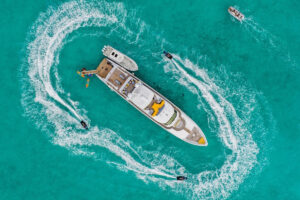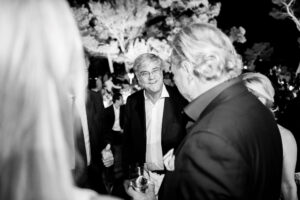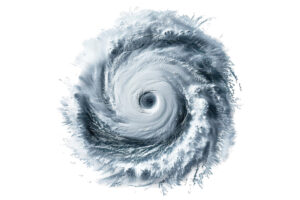There are six of us in a van on the winding road that leads from San Jose to Los Suenos, Costa Rica and we’re trying to pick the better of two flower stands. “Yeah, this one is better. Definitely. Look at the light and that view.” Our driver, Giovanni, had pointed out the roadside racks with bunches of flowers hanging upside down, still dewy in the afternoon sunshine. Now Chris Fischer, host of ESPN’s Offshore Adventures, stands with the show’s chef, Dave Olson, as they position themselves before a staggeringly beautiful view and peel apart a flower. These are flor de hitabo, a white flower from the yucca tree whose blossom looks like a lily of the valley on steroids. Apparently, they are a delicacy with a short season. “Oh, yeah. You have got to make something with these, man. This is perfect for Gourmet Galley.”
The cameras roll while they discuss the flower and how Dave might be able to prepare it back on the boat. The shoot takes five minutes and then we load the van back up and continue on our way to Los Suenos, a trip that takes us from the crystalline air of 3,890 feet above sea level to the sultry shores of the Pacific in about two hours.
The crew has just flown in from Park City, Utah, which is under 6 feet of snow, to meet Ocean, ex Arctic Eagle, the 126-foot steel crabber that has been undergoing improvements in Ensenada for the last few months. The atmosphere in the van is laid back and pura vida is invoked repeatedly. Chris turns to me to explain the concept. In Costa Rica, pura vida, which translates literally as “pure life” is the appropriate response in every situation. It’s the ultimate in mellowness-when we would say cool or it’s all good, Costa Ricans say pura vida.
We stop to film another segment at a fruit market in the town of Orotino. As Dave and Chris sample exquisitely ripe mangoes for the camera, a thief reaches into the van and makes off with the score of a lifetime: a backpack containing Chris’ cell phone, his laptop, his passport, and $6,000 in cash. It’s a minor disaster since we are supposed to clear customs tonight and set sail for Panama. Now, we’ll have to hang around Los Suenos until Monday morning when Chris will drive back to the embassy in San Jose at the crack of dawn to collect a new passport. A pall falls over our little expedition and we ride in silence for a while. But Chris bounces back fast. “Hey, what are you going to do? We’ll just have to roll with it.” Brave words from a guy who just lost his entire electronic life.
And roll with it, we do. Over the next few days, there are some minor generator problems, battery issues and the walk-in freezer conks out but it’s all taken in stride. They’re here to make TV and as Chris says, “People watch to see us having a good time-that’s something you can’t fake. If we’re not having fun, our shows aren’t going to be any good.” It helps, of course, that Ocean keeps a Cabo 45 Express and a Triton 28 center console on deck. In fact, the entire operation is a dream for boys (and girls) who like toys. Next month, they’re picking out a flats boat to add to the inventory. “There will be absolutely nowhere we can’t go,” Chris points out. And when he says nowhere, he means nowhere.
In April, Ocean will set off on a seven year, round-the-world journey. The plan is two-fold: to fish nearly every part of the world, including places that have never been fished before, and to record their scientific findings on these fisheries for posterity.
“I am really passionate about managing our fisheries, so that we can make them sustainable. It upsets me when people go to either extreme on this issue: some people want to shut down fishing altogether and some people want to fish irresponsibly. It’s all about fishing the right way and if we don’t educate people about that, this amazing resource won’t be there for future generations. So, one of the things we hope to do is bring the ocean into people’s homes in a way they’ve never experienced before. We’re going to have an amazing adventure but we also hope to leave a lot of awareness in our wake.”
Ocean was acquired on a deal written on a cocktail napkin and sealed with a handshake. With twin Cat diesels, live bait tanks, an ingenuous built in forklift/cradle for the Cabo and a crane for the Triton, this is the perfect mothership for a round the world adventure.
The crew’s mission on my visit is to film at least 3 episodes of Chris’s two ESPN II shows, “Ocean Hunter” and “Offshore Adventures.” The dozen guys aboard the boat (who are all good sports about having a female crash the party) work like a well-oiled machine. But our trip gets off to a slow start because of the various mechanical issues. When Tuesday evening arrives we’re still in Los Suenos. Thanks to the Cabo and the Triton, there’s been plenty of filming. We’ve been spear hunting for snook from one of the RIBS and trying to land sailfish from the Cabo. Nada. They’re just not biting.
On Wednesday morning, we set off for another full day of fishing while Ocean finally heads down the coast of Costa Rica toward Panama. We’ll rendezvous in the evening.
It’s a glorious day. Plenty of flying fish, countless pods of common dolphins and spinner porpoises. We have a couple of nibbles from sailfish and a blue marlin takes our bonita but spits out the head (and the hook) after a spectacular vertical leap that we roughly translate as the fish equivalent of the middle finger.
While we wait for something else to bite, Chris and I talk about sailfish he saw stacked on the beach. “They’re selling them for $2 each,” he says. “But I read a report recently showing that the average sailfish catch brings $2,000 into the economy. And that’s per fish. When you think of someone flying down here and catching several fish-the airfare, the hotel, the cost of the fishing charter the key is to make people understand that a live sailfish is worth a lot more than a dead one. And then you start the process of figuring out how to make sure that local people share in that economy and make a living.”
That evening, we return to the mothership and head for Panama. I take the 8:00-10:00 watch, stepping outside the bridge periodically to look around. The coast is utterly dark and the stars seem as bright as halogens against the black sky.
In the morning, we gather all the passports and head up river in the Triton to David, to clear customs. The trip is treacherous during low tide, with sneaky sandbars scattered unpredictably around every bend. But it is magnificently wild-we pass only two simple homes peeking out from beneath the palms and mangroves during our 40 minute ride. We’re 480 miles from the equator and the sun already smolders at 10 a.m.
While we wait for customs to clear us in, the guys urge me to email my story and hang with them for the weekend so we can go catch some big fish and explore Panama. But I am now 2 days late getting back to the office, thanks to our shifting plans. Duty calls.
I miss my flight in David and have to wait hours for the next one. I dash across Panama City from the domestic airport to the international airport for a photo-finish arrival. But 17 hours after leaving the Ocean, as I pull my down coat over my tanned arms and start dragging my bags across the dark and deserted long-term parking lot at JFK, I am still able to think pura vida.







